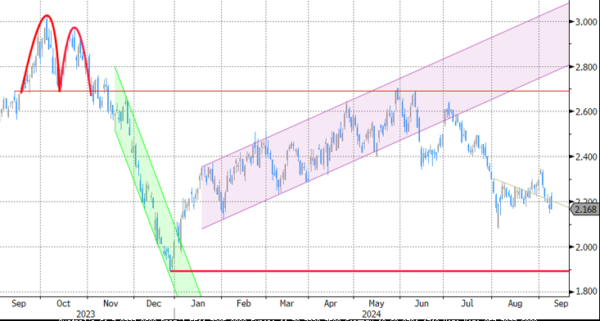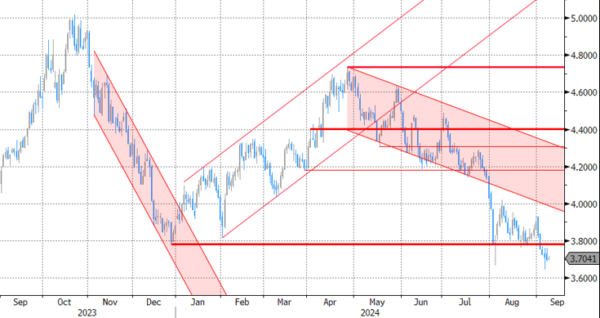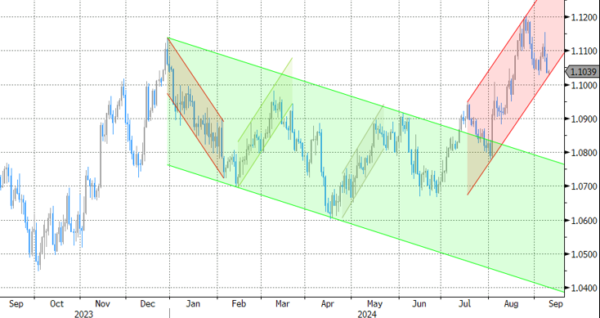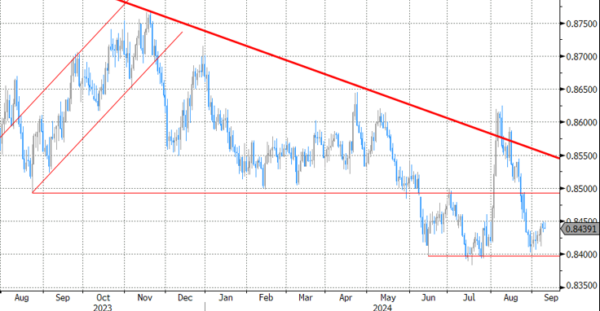Markets
This week’s opening session can be easily classified. Risk sentiment improved somewhat after last week’s beating with key European and US stock markets gaining slightly under/over 1%. That doesn’t cover ground lost though with technical pictures still sending correction vibes. The trade weighted dollar (DXY) last Friday tested the first support in around 100.50/60 in the wake of the payrolls release. The greenback avoided a drop and built on that technical correction momentum yesterday (close 101.55). A move above 102 would be a first technical signal that the USD sell-off momentum since July is morphing into more neutral short term settings. EUR/USD 1.10 is a more or less similar pivot point. Core bonds initially drifted south, but the path of least resistance remains stronger going into this week’s ECB and especially next week’s FOMC meeting. US yields remain stuck at/near this year’s low for all tenors. Today’s empty agenda in the US and EMU suggests more anticipative action ahead of tomorrow’s US August CPI report and Thursday’s ECB meeting. Sterling is a tad stronger after labour market data this morning. Wage growth slowed as expected to 5.1% on an annual basis in the three months to July, while employment rose more than expected in that same time span (+265k 3M/3M). Monthly payrolls for August nevertheless pointed at 59k layoffs (vs +25 k expected).
The ECB is expected to cut its deposit rate for a second time this year by 25 bps, to 3.50%. As announced in March, they will also reduce the spread between the main refinancing rate and the deposit rate from the current 50 bps to only 15 bps implying an MRR rate cut of 60 bps, from 4.25% to 3.65%. Updated GDP and CPI forecasts will be closely watched for clues on the monetary policy trajectory going forward. However, we don’t expect big changes apart from perhaps some minor downward revisions to this year’s GDP and headline CPI data. Recall that ECB staff in June plotted a 0.9%-1.4%-1.6% growth path for 2024-2026 and a 2.5%-2.2%-1.9% inflation trajectory. While keeping an easing bias, we don’t expect the central bank to pre-commit to specific actions at coming meetings. The short intermeeting period between September 12 and October 17 suggests that bar any big surprise, the central bank might be more inclined to sit the October meeting out and stick with the currently, quarterly, rate-reduction scheme with a next 25 bps move coming only in December. Unlike the Fed, the ECB’s options for making policy less restrictive are smaller given limited room towards neutral territory in the current, stubborn, (core) inflationary environment.
News & Views
Investors are urging the Bank of England to expand the maturity range of the bonds it is actively selling under the umbrella of quantitative tightening. The BoE on September 19 announces its new target by which it wants to reduce its gilt portfolio (currently £688bn from a £875bn peak) over the coming 12 months. Sticking to the current pace of £100bn means that the BoE will only actively sell about £13bn (down from about £50bn) of gilts due to a sharp uptick in maturing bonds. These sales will only cover maturities of three years or longer. However, market parties say that the front end of the gilt market is experiencing a notable liquidity problem due to the large stock the BoE holds. Shorter-dated bonds are estimated to be around a third of the total portfolio. Some analysts say this makes them structurally scarce and a potential source of problems in the repo market. Bloomberg’s gilt liquidity tracker has indeed deteriorated in recent weeks to levels seen in the wake of the 2008 financial crisis. Despite the recent improvement it’s still showing poorer liquidity than during the September 2022 gilt crash. Some BoE watchers as a result expect the central bank to actually raise the annual QT target.
The European Commission is mulling sanctions on Robert Fico’s Slovakian government over rule of law concerns. At stake for Slovakia are some of the €12.8bn of allocated European funds and the €2.7bn of EUNextGen grants, officials said. The EU is worried about some recent judicial changes, including a revision to the criminal code that reduces sentences for crimes such as fraud and the decision to scrap an anti-corruption office. The latter was one of the conditions for receiving pandemic-related grants. EU executives are drafting a letter to let Slovakia know it faces punishment. Commission president von der Leyen is said she has yet to decide whether the letter will be sent and when.
Graphs
GE 10y yield
The ECB cut policy rates by 25 bps in June. Stubborn inflation (core, services) make follow-up moves less evident. Markets nevertheless price in two to three more cuts for 2024 as disappointing US and unconvincing EMU activity data rolled in, dragging the long end of the curve down. The move accelerated during the early August market meltdown.
US 10y yield
The Fed in its July meeting paved the way for a first cut in September. It turned attentive to risks to the both sides of its dual mandate as the economy is moving to a better in to balance. The pivot weakened the technical picture in US yields. A string of weak eco data and a risk-off market climate pushed and kept the 10-yr sub 4%. We think we could be up to three 50 bps rate cuts this year.
EUR/USD
EUR/USD moved above the 1.09 resistance area as the dollar lost interest rate support at stealth pace. US recession risks and bets on fast and large rate cuts trumped traditional safe haven flows into USD. EUR/USD 1.1276 (2023 top) serves as next technical references.
EUR/GBP
The BoE delivered a hawkish cut in August. Policy restrictiveness will be further unwound gradually on a pace determined by a broad range of data. The strategy similar to the ECB’s balances out EUR/GBP in a monetary perspective. Recent better UK activity data and a cautious assessment of BoE’s Bailey at Jackson Hole are pushing EUR/GBP lower in the 0.84/0.086 range.















